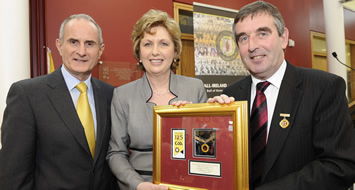President McAleese addresses Gaels
 President of Ireland, Her Excellency Mary McAleese, on Saturday addressed the delegates at the Conference celebrating 125 Years of the GAA in the Cardinal O’Fiaich Memorial Library & Archive in Armagh.
President of Ireland, Her Excellency Mary McAleese, on Saturday addressed the delegates at the Conference celebrating 125 Years of the GAA in the Cardinal O’Fiaich Memorial Library & Archive in Armagh.
Below is a copy of her speech:
To listen to the speech in full, go to www.gaelgames.com
—
Dia dhíbh a chairde. Tá an-áthas orm bheith i bhur measc anseo ar an ócáid speisialta seo. Míle bhuíochas díbh as an gcuireadh agus an fáilte a thug sibh dom.
Good afternoon everyone and thank you for that warm welcome.
Before I talk to you about the very joyful subject of 125 years a-growing by the GAA, I wanted briefly to mark the reality that today is a very different kind of a day for the Carroll and Jordan families in Banbridge as they lay to rest their beloved Stephen Carroll and across in England for the families of Mark Quinsey and Patrick Azimkar as they prepare for the same sad and tragic ritual. First and foremost, our thoughts and prayers are with them and with those who were injured in Massereene. This has been a brutal week for those families and one from which recovery will be a long, difficult process.
But out of the most terrible adversity can come signs of hope. So it has been this week. The reality is that the awful events of Massereene and Craigavon have provoked an overwhelming level of systemic solidarity within Northern Ireland, between North and South and between Ireland and Great Britain. Let those who perpetrated those evil crimes take note – they thought they could divide us as before but the old mould is broken and gone. The peacemakers are now legion and we are not for turning. Politicians and people of different perspectives, on this, speak with one voice. The future is now shared. And the consolidation of that shared future is going to happen through the quiet, relentless work of community and community-building by individuals and organisations on all sides, among them the GAA, investing in friendship-building, in good neighbourliness, in respect for the other’s culture and in exploring opportunities for growing shared memories, shared joys, shared successes.
It is a great pleasure to be here today and be part of this celebration of 125 years of Cuman Luthcleas Gael, an organisation which has given each of the contributors to this conference and millions more, a personal store of powerful, long-lasting memories, allegiances, friendships and connections which have brought colour, vibrancy, meaning and magic to our lives. The GAA, as an organisation, is extraordinary in terms of its reach into home and parish, into county and province, into our nation, in fact wherever two or more are gathered, at home and abroad.
This conference will look at how, over all these many years of its history, through the drama that produced so many variegated chapters in Ireland’s turbulent history, the GAA was born, survived and thrived. If two shortens the road, then the company of the GAA has shortened the road from 1884 to 2009. It has been companion and friend, family and community to generations. It has been and is deeply loved, occasionally a little resented for it has taken tough stances in the face of history’s demands and it has been generously courageous in moving beyond them and beyond the vanities of history.
There is a narrative of sheer pride in the story of these one hundred and twenty-five years and a fresh narrative up ahead as the GAA strides comfortably and confidently through its second century, a legacy of fabulous facilities all over Ireland, not least in Croke Park, 400 dynamic clubs outside Ireland, the Asian Gaelic games going from strength to strength, new facilities in San Francisco, the first full-time Gaelic coach in an English school, all this the result of the work of amateurs, volunteers, who are driven by a determination to make the GAA the best it can be. Why do they bother, year in, year out, the punishing training schedules, the fund-raising, the jersey washing, the aggravation, the committees, the conflicts, the craic? They do it as this conference title says “For Community, Club, County and Country”. It’s a rallying call to goodness, to decency, to mutual interdependence, to sporting excellence, to skill, to working to win, to graciously accepting defeat. In a world that spins and changes, the GAA adapts and endures because its fundamental values endure. Here is an organisation of pure, national solidarity, where people of all backgrounds meet as equals, share a passion for sport and for showcasing our country at its best.
I grew up in Belfast but I was the child of a Down mother and a Roscommon father. That set my GAA allegiances in stone. I remember the 1960s as a sea of red and black, of soaring, mad rip-roaring pride in the accomplishments of those men whose names I could never forget, who came to Croke Park, took on the princes and kings of Kerry and brought the Sam Maguire North for the first time. I still get an anxiety attack thinking about that late penalty from Paddy Doherty that stopped a few Kerry hearts. There is a story told that, just after the penalty as Paddy was strolling back past the legendary Mick O’Connell, Mick asked Paddy how much time was left and the answer was “365 days Mick!”.
How could we ever fully evaluate the influence of those giants of the Sixties for those of us growing up in the divided Northern Ireland of that time? Here were men who seemed to lift, carry and disperse those high-banked clouds of resignation that Seamus Heaney writes about so brilliantly in his poem, “From the Canton of Expectation”. These men changed the mood, infused us with a fierce self-belief, a vision of ourselves as winners and as serious shapers of the GAA.
Years later while I was living in Rostrevor and on the local church pastoral council, I took part in a diocesan workshop in the Cathedral in Newry. We gathered delegates from every parish in Dromore. They gave us massive sheets of paper on which to draw our parishes and the important places in them. When the eighty charts went up on the wall, there it was for all to see – shouting at us from every single piece of paper – were the words GAA. We stood amazed, confronted by a reality we had always known but overlooked – this for many of us was our heartland, the place that united us as family, friends and neighbours. In that same era George Morrison produced his epic film Mise Éire with O’Riada’s thunderingly moving and evocative music. Our story was being told and beautifully, our story was changing driven by a new purposiveness, a fresh voice.
A well-known Unionist sports commentator recently described Croke Park as “the epicentre of Irish sport” – he got that right between the posts. There is no way I could do justice to my own debt to the GAA, the inimitable days of football, hurling, camogie, handball, from under sevens to Senior level, from Sigersons Martin won to Sigersons Martin lost, but when I heard the Marseillaise blast out at the first Six Nations match in Croke Park, I felt a peace of heart and mind like no other. When the English came, an hour and a half before we beat them, the sheer genuineness of the welcome given to them was one of those memories a person takes to the grave, grateful to have been there, to have heard the pin that did not drop, to have felt the shared mood, the viral, infectious mood of goodness and decency. The Irish people, Catholic and Protestant, Unionist and Nationalist placed a lot of trust that day in the GAA – so too did our English neighbours – and the GAA rewarded that trust a thousandfold, as we knew they would – for the GAA is the place that holds a people’s heart with care and with compassion.
A few days ago I was in Croke Park for the launch of the GAA’s Social Initiative designed to reach out to and embrace older men living alone who do not want their lives to be simply solitary but long for sociability again. To be in that room in Croker with the first two hundred men, to hear their excitement and see their happiness was a privilege. To see the massive growth of ladies Gaelic football, to live in hope that Antrim hurlers will one day shake my hand on a September Sunday, to hear my husband groan under the relentless weight of bad economic news a few weeks ago, “Dear God would the Gaelic season ever start”. To watch my kids who once painted their faces red and black head for Parnell Park dressed in Dublin Blue, to argue the footballing and hurling toss with every Seán and Sinead from Belfast to Beijing, these are the gifts of the GAA. I met a young Newry man in Dubai last month, he was coaching fifty under-tens in Gaelic football in his spare time. I asked him why – he said it all – all I want to say… the GAA has given me so much, it is only right to give something back.
It’s a debt that a lifetime could not repay in my own case alone from my days as an undistinguished camogie player, to the days of trudging after my husband and children as they played, the family days as spectators following Rostrevor and Down, the summers spent begging and borrowing tickets for All Ireland Finals so our kids would know and love Croke Park as we knew and loved it and these eleven years as President with the best seats in the house. Camaraderie like no other, craic like no other and community like no other. That is my GAA. And the best is yet to come. Enjoy this conference and this start to the next one hundred and twenty-five years.
I would like to thank our hosts, Comhairle Ulaidh C.L.G, Council President Tom Daly, Council Secretary Danny Murphy and the wonderful and evocative Cardinal Ó Fiaich Memorial Library and Archive for inviting me to give this opening address. I wish your endeavours well, I hope you have fun as well as serious engagements and I wish Ulster football, camogie and hurling, especially Antrim, well – I have three more years of good tickets and I dare to hope.






